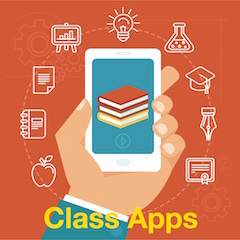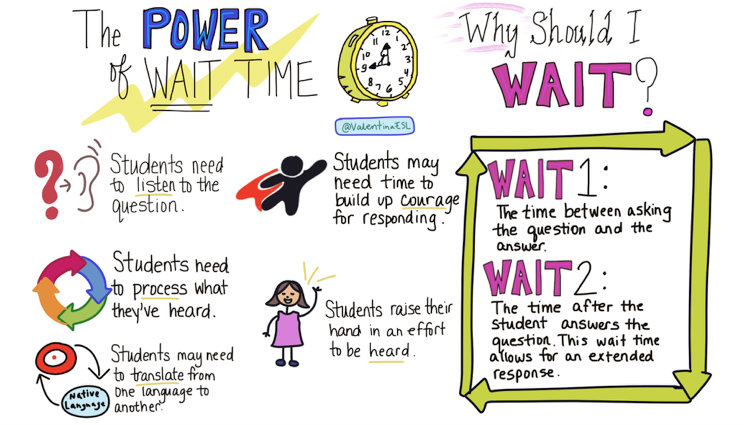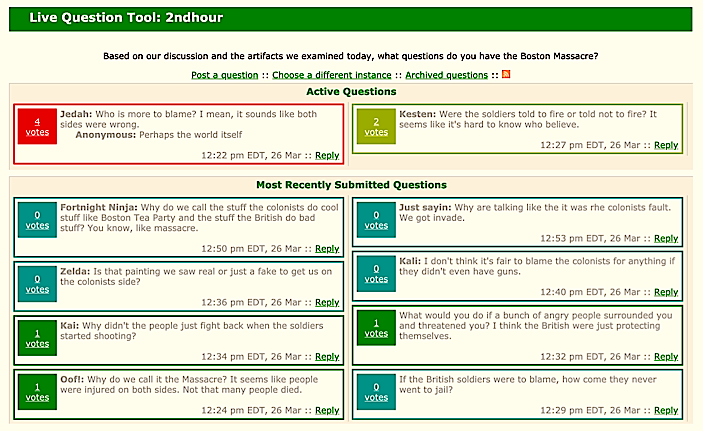Don’t Let Questioning Be Like a Ping Pong Game
A MiddelWeb Blog
 Step in to just about any classroom – mine, your colleague next door or someone else’s – and take a seat. No matter where you are, it won’t be long before you see the teacher posing questions – lots of them – to his/her students.
Step in to just about any classroom – mine, your colleague next door or someone else’s – and take a seat. No matter where you are, it won’t be long before you see the teacher posing questions – lots of them – to his/her students.
Questioning and discussion are two of the most widely utilized instructional strategies (Hattie, 2017). But just because we do it often doesn’t mean that we are necessarily doing it well.
On the surface, asking questions seems like a solid way to get students’ attention, keep them focused on the lesson, and get them thinking about what is being taught (Marzano, 2017). Too often, however, questions become a pedagogical ping-pong paddle used to create a predictable, back-and-forth exchange between teacher and students.
Many of our queries are low-level, cognitive questioning used to verify that most our students are keeping up (Sedova, Salamounova, & Svaricek, 2014). Luckily, it only takes a few, small adjustments to our questions – and how we use them – to engage and deepen the learning of even our most reluctant students.
Student learning depends largely on the attention teachers pay to the types of questions used and how they are employed in the classroom. It also requires us to foster a classroom culture of participation, risk-taking, and evidence-driven discussion.
 Better Questions
Better Questions
Fortunately, research provides several guiding principles and practices for helping us improve the kinds of questions that we pose to students:
- Questions tend to be more effective when teachers take time to plan and structure them in advance.
- Consider individual students’ prior understanding of concepts, topics, and skills be taught.
- Questions that are adapted to students’ cognitive, ability, and vocabulary levels are likely to result in deeper understanding and reduced anxiety (Fusco, 2012).
- Teachers should not shy away from asking in-depth questions of reluctant responders (Marzano, 2016).
- Questions should reflect different degrees of challenge and variety of learning domains such as Webb’s Depth of Knowledge, Bloom’s Taxonomy, and Dimensions of the Brain.
- Teachers should develop different types of questions for different purposes such as focusing, prompting, and probing (Burden & Byrd, 2016).
- Students find learning more meaningful when questions relate to their own lives or situations they find relevant.
- Students with language difficulties benefit from ‘tiered’ questions, or systematic use of prompts that focus on the development of vocabulary, higher-order reasoning, and evaluation/reflection skills (Hay et al., 2007).
Better Questioning and Discussion
As teachers, we should also give careful consideration to the way we utilize questions to spur thinking and engage students in discussion. We can accomplish this when we…
- Phrase questions independently and clearly, rather than bundling two or three questions together. Restate a question if a student is having trouble answering.
- Avoid allowing the same 2-3 kids to dominate class discussion. Instead, keep track of who is/is not contributing, then reinforce high participation expectations for all by giving all students equal response opportunities.
- Provide students opportunities/time to prepare for whole classroom discussion (i.e…think-time, writing down individual thoughts, and/or pairing-sharing with those around them).
- Resist panicking if students don’t answer immediately. Allow them enough wait time after a question (and in between student responses) to process questions and formulate a quality response.
- .
Valentina Gonzalez. Click to enlarge.
- Ask follow up questions and encourage all students to support answers with support and evidence.
- Clearly structure and monitor pair-share/small group discussions by making clear the parameters, procedure, and expectations.
- Build in regular opportunities and supports for students to develop their own questions.
- Thank each student who offers up an answer or question, whether it is correct or not.
Sites and Web Tools for Questioning and Discussion
Stanford Teaching Commons has a variety of fantastic resources for teachers looking to improve the learning of their students. One of my favorites are their research-based suggestions for fostering student participation/discussion. Another great how-to resource right here on MiddleWeb is Jackie Walsh’s article Students Learn from Inquiry, Not Interrogation.
For a few years now, Poll Everywhere, Padlet, and Nearpod have been my go-to tools for teachers and students to share responses to traditional and open-ended questions. Students can respond to a variety of open-ended, multiple choice, or ranking questions designed from any internet-connected device or smart phone. Responses can be displayed in real time or saved for later. Students can also create their own questions/polls as a cross-teaching strategy.
Recently a teacher friend of mine introduced me to the Live Question Tool. It allows his students to pose questions electronically and then vote on which ones are the most important or relevant based on the lesson. Below is an example from one of his lessons.
DirectPoll is a free, easy tool for teachers to instantly set up a poll using ‘Yes’, ‘No’ and ‘Don’t Know’ options to check for student understanding. It requires no sign-up and can be used at any time by accessing the home page and clicking on Start Poll. Results can be displayed in real-time via your browser.
GoSoapBox has a Social Q/A feature that allows students to anonymously type a question instead of raising their hand to ask. They can view or vote on these, and teachers can mark them as answered as they are discussed in class. The Discussions tool allows group members to comment – anonymously, if desired – on a post. There is even a Confusion Barometer tool allows students to toggle their status from “getting it” to “confused.” The tool is free for small classes (fewer than 30 students), and can be upgraded for larger class sizes for a small fee.
Conclusion
If we aren’t careful, our classrooms can become saturated with teacher talk and superficial questioning. Quality learning experiences result when teachers (and students) pose and engage with questions of various types and degrees of challenge.
Our students all have something to contribute. Our task is to get them thinking, sharing, and participating in evidence-driven discussion.
See other MiddleWeb articles
about Questioning & Discussion
References
Burden, P. R., & Byrd, D. M. (2016). Methods for effective teaching: Meeting the needs of all students.
Fusco, E. (2012). Effective questioning strategies in the classroom: A step-by-step approach to engaged thinking and learning, K-8. Teachers College Press.
Hay, I., Elias, G., Fielding-Barnsley, R., Homel, R., & Freiberg, K. (2007). Language delays, reading delays, and learning difficulties: interactive elements requiring multidimensional programming. Journal of Learning Disabilities, 40(5), 400-409.
Hattie, J. (2017). Visible learning for teachers: Maximizing impact on learning.
Marzano, R. J. (2017). The new art and science of teaching.
Marzano Research. (2016). Asking in-depth questions of reluctant learners. Centennial, CO : Author.
Sedova, K., Salamounova, Z., & Svaricek, R. (2014). Troubles with dialogic teaching. Learning, Culture and Social Interaction, 3(4), 274-285.
































